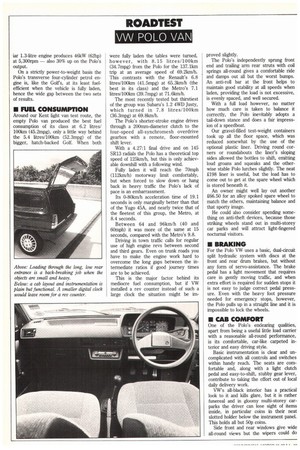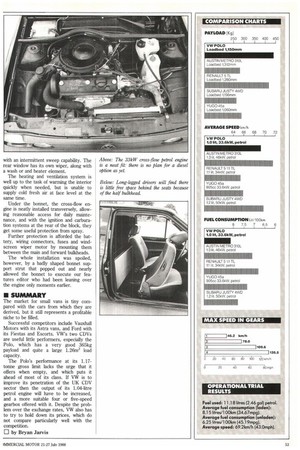ROADTEST VIA/ POLO VA\
Page 40

Page 41

If you've noticed an error in this article please click here to report it so we can fix it.
• jar 1.3-litre engine produces 46kW (62hp) at 5,300rpm — also 30% up on the Polo's output.
On a strictly power-to-weight basis the Polo's transverse four-cylinder petrol engine is, Ifice the Golfs, at its least fuelefficient when the vehicle is fully laden, hence the wide gap between the two sets of results.
• FUEL CONSUMPTION
Around our Kent light van test route, the empty Polo van produced the best fuel consumption of its class at 6.2 litres/ 1001un (45.2mpg), only a little way behind the 5.4 litres/100km (52.3mpg) of the bigger, hatch-backed Golf. When both Above: Loading through the long, low rear entrance is a back-breaking job when the objects are small and heavy.
Below: a cab layout and instrumentation is plain but functional. A smaller digital clock would leave room for a rev counter. were fully laden the tables were turned, however, with 8.15 litres/100km (34.7mpg) from the Polo for the 137.1km trip at an average speed of 69.2km/h. This contrasts with the Renault's 6.8 litres/100Icm (41.5mpg) at 65.31an/h (the best in its class) and the Metro's 7.1 litres/100Icm (39.7mpg) at 71.6km/h.
The most recently tested but thirstiest of the group was Subaru's 1.2 4WD Justy, which turned in 7.8 litres/100km (36.3mpg) at 69.8Icm/h.
The Polo's shorter-stroke engine drives through a 200mm-diameter clutch to the four-speed all-synchromesh overdrive gearbox with a remote, floor-mounted shift lever.
With a 4.27:1 final drive and on 145 SR13 radials the Polo has a theoretical top speed of 1251cm/h, but this is only achievable downhill with a following wind.
Fully laden it will reach the 70mph (112Iun/h) motorway limit comfortably, but when forced to slow down or hang back in heavy traffic the Polo's lack of pace is an embarrassment.
Its 0-80Ian/h acceleration time of 19.1 seconds is only marginally better than that of the Yugo 45A, and nearly twice that of the fleetest of this group, the Metro, at 8.4 seconds.
Between 64 and 96km/h (40 and 60mph) it was more of the same at 15 seconds, compared with the Metro's 9.8.
Driving in town traffic calls for regular use of high engine revs between second and third gears. Even on trunk roads you have to make the engine work hard to overcome the long gaps between the intermediate ratios if good journey times are to be achieved.
This is the major factor behind its mediocre fuel consumption, but if VW installed a rev counter instead of such a large clock the situation might be im proved slightly.
The Polo's independently sprung front end and trailing arm rear struts with coil springs all-round gives a comfortable ride and damps out all but the worst bumps. An anti-roll bar at the front helps to maintain good stability at all speeds when laden, providing the load is not excessive, is evenly spaced, and well secured.
With a full load however, no matter how much care is taken to balance it correctly, the Polo inevitably adopts a tail-down stance and does a fair impression of a speedboat.
Our gravel-filled test-weight containers took up all the floor space, which was reduced somewhat by the use of the optional plastic liner. Driving round corners or roundabouts the liner's sloping sides allowed the bottles to shift, emitting loud groans and squeaks and the otherwise stable Polo lurches slightly. The neat 198 liner is useful, but the load has to come out to get at the spare wheel which is stored beneath it.
An owner might well lay out another 266.50 for an alloy spoked spare wheel to match the others, maintaining balance and that sporty image.
He could also consider spending something on anti-theft devices, because those striking wheels stand out in multi-storey car parks and will attract light-fingered nocturnal visitors.
• BRAKING
For the Polo VW uses a basic, dual-circuit split hydraulic system with discs at the front and rear drum brakes, but without any form of servo-assistance. The brake pedal has a light movement that requires care in gently moving traffic, and when extra effort is required for sudden stops it is not easy to judge correct pedal pressure. Even with the heavy foot pressure needed for emergency stops, however, the Polo pulls up in a straight line and it is impossible to lock the wheels.
• CAB COMFORT
One of the Polo's endearing qualities, apart from being a useful little load carrier with a reasonable all-round performance, is its comfortable, car-like carpeted interior and easy driving style.
Basic instrumentation is clear and uncomplicated with all controls and switches within handy reach. The seats are comfortable and, along with a light clutch pedal and easy-to-shift, stubby gear lever, contribute to taking the effort out of local daily delivery work.
VW's all-black interior has a practical look to it and kills glare, but it is rather funereal and in gloomy multi-storey carparks the driver can lose sight of items inside, in particular coins in their neat slotted holder below the instrument panel. This holds all but 50p coins.
Side front and rear windows give wide all-round views but the wipers could do with an intermittent sweep capability. The rear window has its own wiper, along with a wash or and heater element.
The heating and ventilation system is well up to the task of warming the interior quickly when needed, but is unable to supply cold fresh air at face level at the same time.
Under the bonnet, the cross-flow engine is neatly installed transversely, allowing reasonable access for daily maintenance, and with the ignition and carburation systems at the rear of the block, they get some useful protection from spray.
Further protection is afforded the battery, wiring connectors, fuses and windscreen wiper motor by mounting them between the main and forward bulkheads.
The whole installation was spoiled, however, by a badly shaped bonnet support strut that popped out and nearly allowed the bonnet to execute our features editor who had been leaning over the engine only moments earlier.
• SUMMARY
The market for small vans is tiny compared with the cars from which they are derived, but it still represents a profitable niche to be filled.
Successful competitors include Vauxhall Motors with its Astra vans, and Ford with its Fiestas and Escorts. VW's two CDVs are useful little performers, especially the Polo, which has a very good 365kg payload and quite a large 1.26m3 load capacity.
The Polo's performance at its 1.17tonne gross limit lacks the urge that it offers when empty, and which puts it ahead of most of its class. If VW is to improve its penetration of the UK CDV sector then the output of its 1.04-litre petrol engine will have to be increased, and a more suitable four or five-speed gearbox offered with it. Despite the problem over the exchange rates, VW also has to try to hold down its prices, which do not compare particularly well with the competition.
0 by Bryan Jarvis




























































